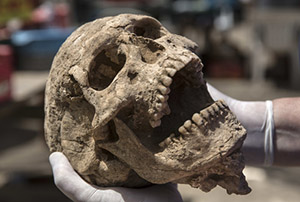The Enigmatic Elongated Skulls of Paracas—Ancient Ritual or Hidden Chapter of Humanity?

On the barren windswept lands of Paracas, Peru, archaeologists unearthed one of the most puzzling relics of South America’s past: a collection of elongated human skulls, dramatic in form and haunting in their silence. Unlike the round crania familiar to us, these skulls are strikingly stretched—foreheads rising high and narrow, shapes distorted in ways that seem almost otherworldly. For decades, they have challenged researchers to answer a question that cuts to the core of our shared past: were these skulls the result of ritualistic cultural practices, or do they hint at an unknown chapter in human evolution?

Anthropologists lean toward a cultural explanation. Across multiple ancient civilizations—from the Maya of Mesoamerica to tribes in Africa and Eurasia—cranial modification was a known ritual. Infants’ heads were bound with cloth or wood, reshaping the skull as it grew. In Paracas, such practices may have been used to denote status, identity, or spiritual significance. The elongated form may have symbolized connection to the divine, separation from common people, or even the embodiment of mythical ancestors. Within this interpretation, the skulls are testaments to human ingenuity and belief, a literal reshaping of the body to reflect cultural ideals.
Yet, for others, the Paracas skulls remain far from explained. Their extreme proportions and occasional anatomical anomalies—such as unusual cranial capacity or differing bone structures—have fueled speculation. Could these be evidence of a lost genetic lineage, an evolutionary branch erased from history? Or do they hint, as fringe theorists suggest, at extraterrestrial influence or beings remembered in ancient myth? Though mainstream science dismisses alien theories, the allure of the unknown has kept the debate alive in documentaries, books, and popular imagination.

The stark desert backdrop adds to the mystery. Paracas is a land of vast dunes and hidden tombs, where civilizations thrived in isolation long before the Inca Empire. Its people left behind intricate textiles, burial chambers, and enigmatic geoglyphs carved into the earth—clues to a worldview steeped in ritual and symbolism. The skulls fit within this context, as both archaeological evidence and cultural enigma. But their silence is deafening: no inscriptions, no texts, no clear explanations survive to tell us why such dramatic transformations were pursued.
Skeptics remind us that extraordinary claims demand extraordinary evidence. DNA testing of Paracas skulls has produced conflicting interpretations, with some analyses confirming typical human lineages and others raising more questions than answers. Until consistent, peer-reviewed studies are conducted, the skulls remain ambiguous witnesses—half science, half legend.

Still, the discovery’s power lies not only in what it tells us but in what it makes us imagine. The elongated skulls of Paracas embody the human drive to transcend the ordinary, to carve identity into flesh and bone, and to leave behind puzzles for future generations. They remind us that history is not neat, but layered, full of mysteries waiting beneath the sand.
Silent yet commanding, the skulls stand as guardians of an ancient story that resists resolution—whispering across time that the past will never be fully explained.
#ArchaeologySecrets #AncientPeru #ParacasMystery #LostCivilizations #HumanOrigins











